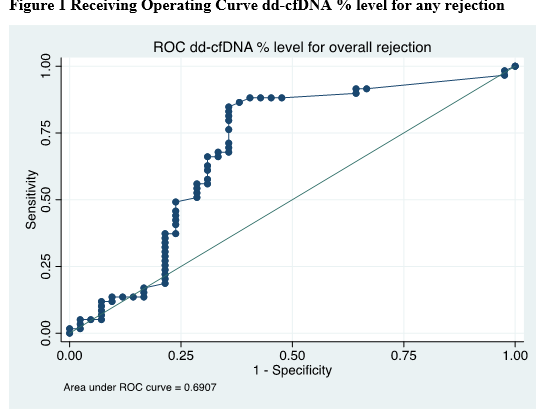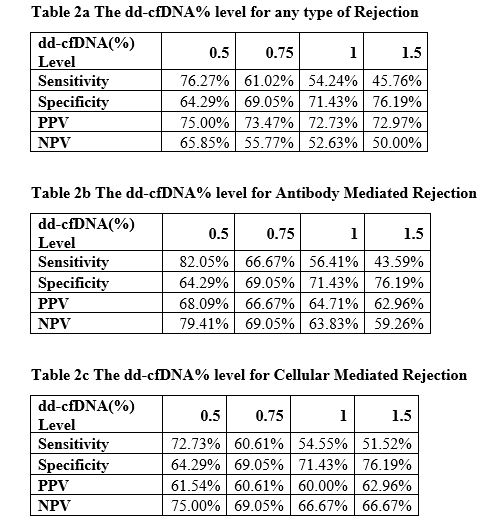Re-Examining the Optimal Threshold for Donor Derived Cell Free DNA in Renal Allograft Rejection
1Washington University in St. Louis, St Louis, MO, 2Washington University in St. Louis, Saint Louis, MO
Meeting: 2022 American Transplant Congress
Abstract number: 1570
Keywords: Biopsy, Kidney transplantation, Rejection, Renal dysfunction
Topic: Basic Science » Basic Clinical Science » 17 - Biomarkers: Clinical Outcomes
Session Information
Session Name: Biomarkers: Clinical Outcomes
Session Type: Poster Abstract
Date: Tuesday, June 7, 2022
Session Time: 7:00pm-8:00pm
 Presentation Time: 7:00pm-8:00pm
Presentation Time: 7:00pm-8:00pm
Location: Hynes Halls C & D
*Purpose: Due to the invasive nature and potential complications of allograft biopsies, there is an important role for surrogate biomarkers to help identify rejection early, as well as treating subclinical rejection. Donor derived cell free DNA (dd-cfDNA) is one such putative biomarker that is becoming increasingly utilized in transplant recipients. With it’s high negative predictive value (NPV), it serves as a useful rule-out test. While most clinicians use 1% as the diagnostic threshold for predicting AMR, our study has tried to elucidate if a lower threshold would be more clinically useful.
*Methods: We prospectively collected the dd-cfDNA levels in patients that had a “for cause” renal transplant biopsy between September 2017 and December 2020. These dd-cfDNA values were obtained within 8 weeks prior to the biopsy. We tested the association of rejection with dd-cfDNA thresholds of 0.5%, 0.75% , 1% and 1.5% and compared them to biopsies with no rejection.
*Results: A total of 101 cases were included, of which 59 had rejection. The area under the receiver operating curve was 0.69 for both any rejection (figure 1) and antibody mediated rejection. A graph of the varying sensitivities, specificities, positive predictive value (PPV) and negative predictive value (NPV) for each cutoff of dd-cfDNA is given in Table 2. Notably, a cutoff of 0.75% rather than 1% performed better in predicting all types of rejection, giving an NPV of 69% for both antibody mediated and cellular rejection.
*Conclusions: Our results suggest that a lower dd-cfDNA threshold of 0.75% had a higher NPV as well as PPV than a threshold of 1%. Furthermore, we feel that dd-cfDNA values are perhaps better used in a dose dependent fashion to predict the likelihood of rejection rather than simply as a positive or negative test.
To cite this abstract in AMA style:
Murad H, Merzkani M, Ji M, Chang S, Malone A, Santos RDelos, Alhamad T. Re-Examining the Optimal Threshold for Donor Derived Cell Free DNA in Renal Allograft Rejection [abstract]. Am J Transplant. 2022; 22 (suppl 3). https://atcmeetingabstracts.com/abstract/re-examining-the-optimal-threshold-for-donor-derived-cell-free-dna-in-renal-allograft-rejection/. Accessed December 27, 2025.« Back to 2022 American Transplant Congress


